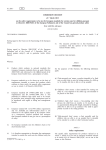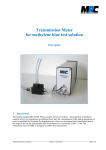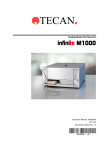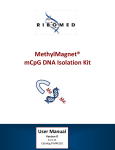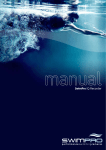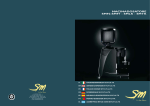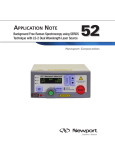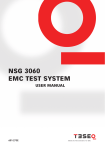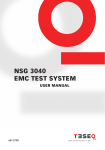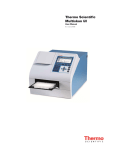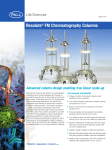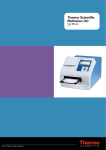Download How do you increase your labs DNA reproducibility
Transcript
How do you increase your labs DNA reproducibility by 50% in your experiments? Here you go again. Filling that old 10 mm cuvette with a giant amount of test solution. You carefully place the cuvette down and you turn to sip your coffee. All of a sudden your arm grazes the cuvette and you spill that expensive DNA sample all over the work area. NSG Precision Cells, designer and manufacturer of cuvettes, is happy to release the most advanced cuvette in the world. This micro volume cuvette uses a mere 1.9ul drop of sample and provides unmatched ease of use and accuracy. We proudly present the “Micro Focus Cell” (MFC) to the spectroscopy world. The Micro Focus Cell is a researcher’s dream come true. Combining the essentials that every researcher has in mind: small sample size, ease of use, cleaning, and cost. The MFC provides the best micro cuvette for any experiment. Micro Focus Cell Design The Micro Focus Cell is the only ultra micro cuvette that utilizes a two part design. The first part is the “Optical Body” (OB). The OB houses the highly polished micro focusing lenses. These lenses send the spectrophotometer’s beam directly through the sample, while keeping the optical beam unaltered. The OB has the same dimensions as a standard 10 mm cuvette (12.5 x 12.5 x 455 mm). The second part of the Micro Focus Cell is the “Micro Chamber (MC).” The Micro Chamber is where the sample is placed. The MC is removable from the OB so a sample can be loaded either in the spectrophotometer or on the workbench. The design of the MC is very sophisticated. You can knock it over and the sample will stay safely in place. www.mi cro f o cus c el l.c om Using the Micro Focus Cell When using the MFC, the only tools required are a spectrophotometer and a micro pipette. Simply take a 1.9 ul drop of solution, place it on the Micro Chamber and slide the MC into the Optical Body. Run the test, clean, and you’re ready for another sample. The whole process takes less than one minute. Hydrodynamic Cleaning & Cross Contamination One of the areas where other drop-based cuvettes fall short is in cleaning. All other designs use two plates to compress the sample in the holder. What happens is One Touch Cleaning Illustrated below is how quick and easy it is to clean the quartz chamber of the MFC. In three quick and easy steps you are ready to run your next sample with zero cross contamination. that when users accidentally use too much sample they end up having the sample leak out of the cuvette when the plates are assembled. This causes many problems with cross-contamination and cleaning. The MFC’s Micro Chamber uses one piece of high-grade ES Quartz to hold the sample. The sample rests directly in the quartz chamber and there are no other pieces to assemble. Once you place the sample in the holder, all you need to do is insert the MC into the Optical Body. To clean, you simply place a laboratory grade cleaning swab on top of the MC. The sample is quickly cleaned within seconds. Samples can also be retrieved by using a micro pipette. Cross Contamination Cross contamination was tested by NRC Canada and they verified that the cross contamination spec for the Micro Focus Cell is 3.5 au. In simple numbers, this translates to 0.0001% or 1/10,000th of the samples transmittance value is effected by the cross contamination of the MFC. All that remained of the previous sample was 0.0001%. The Micro Focus Cell is the only drop based micro cell that does not require concentrated bleach for cleaning. Simply using distilled water, reduces the cross contamination to zero. www.m ic rofoc u s c e ll. c om Perfect Alignment Equals Perfect Reproducibility In the past, the Hellma TrayCell was a great drop based micro cuvette. The design used a series of mirrors to direct the optical beam through the sample (which was at the top of the cell) and then back down to the spectrophotometer’s detector. This design has some limitations. If you did not align the cell 100% correctly with the beam, the cell would not work. The TrayCell was only recommended for a few machines and was not guaranteed to work in all spectrophotometers. Hydro-Grip Technology Have you ever spilt a sample from a cuvette before? Now with NSG’s Hydro-Grip Technology, you will never spill another sample again. Hydro-Grip Technology is the system we designed that keeps the sample in place no matter what direction you turn the Micro Chamber. By fine-tuning the dimensions of the quartz chamber, we have made it virtually impossible for a user to spill a sample once it has been placed into the Micro Chamber. You can knock the Micro Chamber over and the sample will stay in place. What Z-Dimension do you have? There are a large amount of spectrophotometers on the NSG’s MFC eliminates all issues that are caused by misalignment. The first use of the MFC does require a quick alignment procedure and since the Optical Body stays in the spectrophotometer, no further adjustments are required. The alignment procedure consists of inserting the OB and MC together into the spectrophotometer. Then choose either “Baseline 0” or “Baseline Correction” and you are done. market. All people buying cuvettes will already own a spectrophotometer. There is nothing more frustrating than buying a cuvette and then finding out that the Z-Dimension is incorrect. When purchasing a Micro Focus Cell you don’t need to worry about dimensions. NSG has ensured that the MFC is compatible with all spectrophotometers. You can have a 8.5, 15 or even 20 mm ZD. One Micro Focus Cell will work in all of them. NSG is the only company that guarantees that the Micro Focus Cell will work with any spectrophotometer with a 10 mm cell holder. www. m ic rofoc u s c e ll. c om Advanced Optics System The Micro Focus Cell uses a sequence of highly polished Fresnel lenses. These special lenses guide the optical beam directly through the sample. The alignment of the MFC is very easy as long as the beam is in line with the 4-mm round window (see left photo). Once the optical beam comes into contact with the round window, the beam is sent through the Micro Chamber and to the spectrophotometers detector. We believe in keeping the optics as simply as possible. The MFC does not use any mirrors, prisms, or other optics. Multiple Loading Configurations When designing the MFC, NSG had one goal at the top of their list which was ease of use. NSG needed to meet the needs of the most demanding conditions, so we designed the MFC to provide you with maximum flexibility. Samples can be loaded in by keeping the Micro Chamber in the Optical Body or by removing the MC. If for some reason your sample is in the lab down the hall, simply take the MC with you. It cannot be any easier. Locked Lightpath What guarantees consistent results? That’s easy, keeping all variables the same test after test. All other micro cells use a method of pressing two plates together placed directly into this chamber. There is no need to assemble or disassemble the sample holder. Once the to make a seal. Using this method, a user is able to easily insert the sample on the cell. The problem with this is that the lightpath can be different for sample has been placed in the Micro Chamber you only need to insert it into the Optical Body. every measurement. This results in inconsistent results and does not provide the accuracy that you need for DNA tests. The MFC is the only drop-based cuvette Another benefit of this design is that you will not waste one drop of your sample. When using the that has a Locked Lightpath of 1 mm. This lightpath never changes because the quartz optics on the micro chamber pressing plates design, if you are not 100% accurate, the sample can leak out due to is made of one solid piece. The sample is the compression. www.m ic rofoc u s c e ll. c om Wavelength Stability Photometric Absorbance Wavelength stability is the ability of a micro cell to measure peaks accurately test after test. Wavelength peaks are dependent The Micro Focus Cell is the only drop based cell that uses a sequence of Fresnel lenses in the optics design. The largest lens used has a diameter of 6 mm. Using a lens with such a of the purity of the sample used for an experiment. The Micro Focus Cell offers the following features to ensure there are no shifts in the wavelength peaks. large diameter gives users the power of harnessing 50% of the light reaching the spectrophotometers detector. This large amount of light reaching the detector is not changed by the angular position of the cell. 1. The beam entering the cell does not get altered from the beam exiting the cell. In other words, the beam remains unchanged by the MFC. 2. The angular inclination of the beam is unchanged when using the MFC. Applications for the Micro Focus Cell - DNA Quantification - RNA Measurement - DNA Measurement - Nucleic Acid Analysis - Protein Concentration Linearity Data for … (what is the sample) Sample www. m ic rofoc u s c e ll. c om Certified by NRC Canada NSG Precision Cells is proud to be the only company in the world that has received a certification from NRC Canada for a micro cell. Excerpts from NRC Report Wavelength Repeatability Tests: We prepared three types of the said above protein solution: 1. Concentration: 100% 2. Concentration 10% 3. Concentration 1% Other: We never incurred any leakage of liquid samples from the MFC’s cavity. Technical Specifications NSG Part Number MFC-1 --------------------------------------------------------------------------------------- Outer Dimensions (mm) Lightpath (mm) 1.0 --------------------------------------------------------------------------------------- Minimum Sample Volume (µl) All solutions produced a very strong sharp wavelength pick in the long-UV region of the spectrum. DNA Detection Limit (ng/µl) 0.5 --------------------------------------------------------------------------------------- 1,800 --------------------------------------------------------------------------------------- DNA Reproducibility at 100 (ng/µl)* ±0.4 --------------------------------------------------------------------------------------- DNA Reproducibility at 1000 (ng/µl)* ±1.8 --------------------------------------------------------------------------------------- Protein Detection Limit (mg/ml)* 0.025 --------------------------------------------------------------------------------------- Protein Reproducibility at 1 mg/ml** ±0.004 --------------------------------------------------------------------------------------- Protein Reproducibility at 10 mg/ml** Wavelength tolerances in all measurements were within quite tight tolerances of the spectrophotometer we used (refer to the spectrophotometer’s User Manual). Photometric deviation caused by mechanical instability of the spectrophotometer’s cell holder did not cause any issues with wavelength repeatability. 1.9 --------------------------------------------------------------------------------------- DNA Max Concentration (ng/µl) Note: lab-quality distilled water was used as a solvent. 12.5 x 12.5 x 45 --------------------------------------------------------------------------------------- ±0.001 --------------------------------------------------------------------------------------- Protein Maximum Concentration** 110 mg/ml --------------------------------------------------------------------------------------Notes: *Technical performance determine using a biopharm-grade double-beam UV-VIS spectrophotometer with a 2nm spectral bandwidth (Xenon lamp) ** BSA determined with A280 direct-UV method. Maximum concentration is limited by a specimen solubility. Cross-contamination Tests: Lifetime Warranty We measured several times the said pick’s absorbance with samples of all concentrations mentioned above. Then, just by touching the top of the elevated cavity of the MFC device with a swab supplied by the NSG Precisions Cells Inc.’s (www.precisioncells.com), we were able to easily remove liquids-samples from the said cavity. NSG Precision Cells has become well known for offering Lifetime Warranties on select exclusive items. The Micro Focus Cell comes with a Lifetime Warranty so if the MFC is damaged in anyway, NSG will replace the damaged cell with a brand new one. When distilled water was used following a swab’s suction of the sample described above, the photometric absorption of the residual sample’s film was about 0.2 AU, which is within the baseline noise discussed above. Important: any our attempts to further clean the MFC’s cavity with the concentrated bleach did not result in any additional reduction of the photometric absorption which demonstrated no need of using bleach cleaning for the MFC device within the scope of our evaluation. www.m ic rofoc u s c e ll. c om Try One Risk Free NSG needs you to stop wasting your time and money on other cuvettes. You too can increase the efficiency in DNA experiments in your lab by using a Micro Focus Cell. Try a Micro Focus Cell now, risk-free. If the MFC doesn’t give you increased productivity in your daily experiments or if you’re not completely satisfied with it, just let us know within 14 days and simply send the cell back to us. We’ll even pay the shipping cost. Say yes to this offer and we will put the power of a Micro Focus Cell in your hands. Top 11 Reasons for You to Buy a Micro Focus Cell Now 1. Best reproducibility for your experiments. The MFC features a Locked Lightpath as well as perfect alignment eliminating all possible variables. 2. Easy for you to load your sample. The MFC provides you with flexibility to load your sample in or outside your spectrophotometer. 3. You’ll never spill or waste a sample. The Hydro Grip Technology of the Micro Chamber allows you the ability of turning the MFC upside-down or you can toss the Micro Chamber to a colleague across the room and the sample will stay safely in place. 4. Guaranteed to work in your spectrophotometer. NSG guarantees that the MFC will work in any spectrophotometer you own. ZD is adjusted using the black inserts that come with the MFC. 5. Perfect alignment for more control of your experiment. The MFC Optical Body can stay inside the spectrophotometer giving you the same alignment for each test. 6. You can clean the cell in seconds with no carry-over. The One Touch Hydro-dynamic cleaning system sucks the sample out of the cell with 3 seconds when using one of NSGs cleaning swabs. 7. The MFC is easy for you to use. Unlike all other drop based cuvettes, the MFC does not need to have two pieces of quartz pressed together to work. Simply place a drop on the Micro Chamber and insert it into the Optical Body. This provides a leak proof loading system that saves time and money. 8. Locked Lightpath Technology. Get the consistent results you need with a lightpath that does not change. The “Locked” lightpath does not rely on two plates being compressed to form a seal. The MFC has a consistent 1mm lightpath so you know your results will be accurate test after test. 9. Try the MFC in your lab risk free. For a limited time, NSG is offering you the chance to try the MFC 100% free. If you are not 100% satisfied with the performance of the MFC, simply mail it back to NSG within 2 weeks. NSG will even pay the return shipping so you don’t have to invest any of your money. 10. Lifetime Warranty. The MFC comes with a lifetime warranty so if the MFC is damaged in anyway, NSG will replace the damaged part(s) with a brand new one. 11. The MFC is the only micro cuvette that is Certified by NRC Canada. www. m ic rofoc u s c e ll. c om







